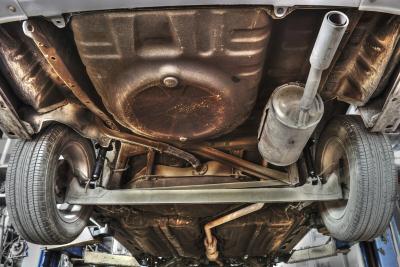
Along with blinker fluid and muffler bearings, "rust proofing" seems like one of those terms unscrupulous used car salesmen and mechanics use to pry away a few more of your hard-earned dollars. The fact is that in many areas, particularly those south of the Mason Dixon line where it rarely snows, it really is a waste of money. Rust-proofing (aka undercoating), as it's known on cars, only protects the bottom of the vehicle under certain conditions, but stops far short of protecting the whole car as the name might imply. However, it does have its uses.
Undercoating dates back as far as man has made vehicles that rust. The first known types were of pine resin and asphalt tar and were applied to the exposed iron components of sailing ships to prevent corrosion caused by constant salt-air exposure. Indeed, most types of undercoating are used for just this purpose. Henry Ford recognized this, when he began offering undercoating as an option as far back as 1940.
Though the bottom of the automobile rarely receives its due attention, the fact is that it is this unsung hero that bears the brunt of the road's many assaults. The most damaging of these is undoubtedly the salt used to clear frozen roads of ice. While fairly inert in its solid form, salt does melt snow and gets absorbed into the water that forms in the road. This highly corrosive salt water settles into the small crevices found underneath all cars and proceeds to eat everything it comes in contact with.
In these environments, undercoating can prove quite invaluable both as an anti-corrosive and a sealant. Some vehicles have exhibited significant structural damage from salt exposure after as few as two winters, so undercoating should be considered a must if the vehicle regularly operates in these conditions.
All undercoating is essentially the same, as it is essentially a thick glue that is designed to stay wet and sticky for as long as possible. Most undercoating contains a binding agent, such as asphalt or epoxy, and solid components, such as fiberglass or ceramic nodules. These solid components help to strengthen the undercoating and, in some cases, can provide a significant amount of sound-deadening.
Store-bought rubberized undercoatings are essentially a spray-on, room-temperature vulcanizing sealant. These types usually go on too thin to provide adequate protection and are notorious for developing bubbles and trapping water against the chassis.
If left to its own devices, undercoating will eventually harden and begin to chip away, so it just is not a set-and-forget procedure. Undercoating can add a significant amount of weight, particularly the old-fashioned asphalt-types if laid on thicker than necessary. However, the main drawback to any sort of "rust-proofing" is that, improperly applied and maintained, they can actually increase the rate of your car's decay. If a particularly thin portion is directly adjunct to a thick portion, the thinner part can chip away and trap moisture between the thick portion and the body, accelerating corrosion significantly.
The automotive community has reached a general consensus that factory undercoating jobs aren't worth the paper they're billed on. Generally, manufacturers apply only a thin coat of the cheapest rust-proofing available at the factory and is likely already six months old by the time it reaches your driveway.
You can apply your own rust proofing, but it may be worth the money to take your car to a shop that specializes in the procedure. As mentioned above, improper application can cause far more harm than good.